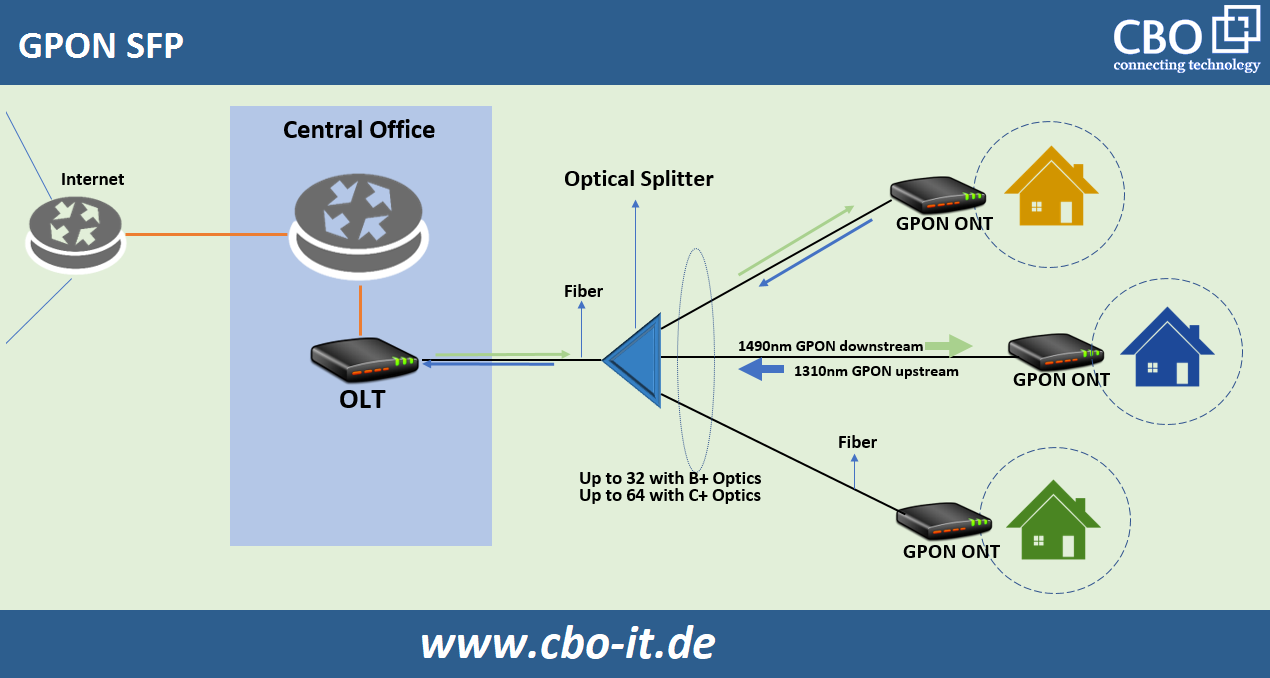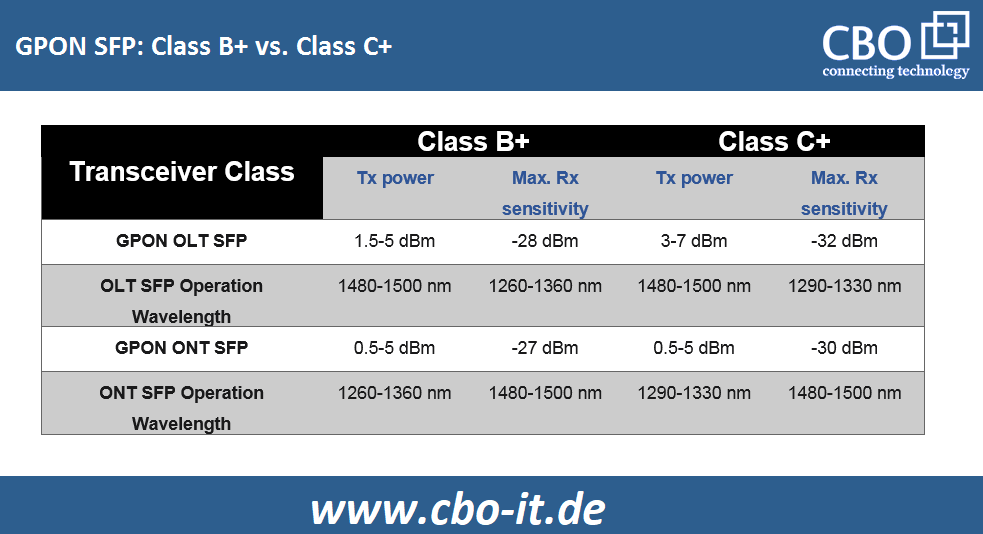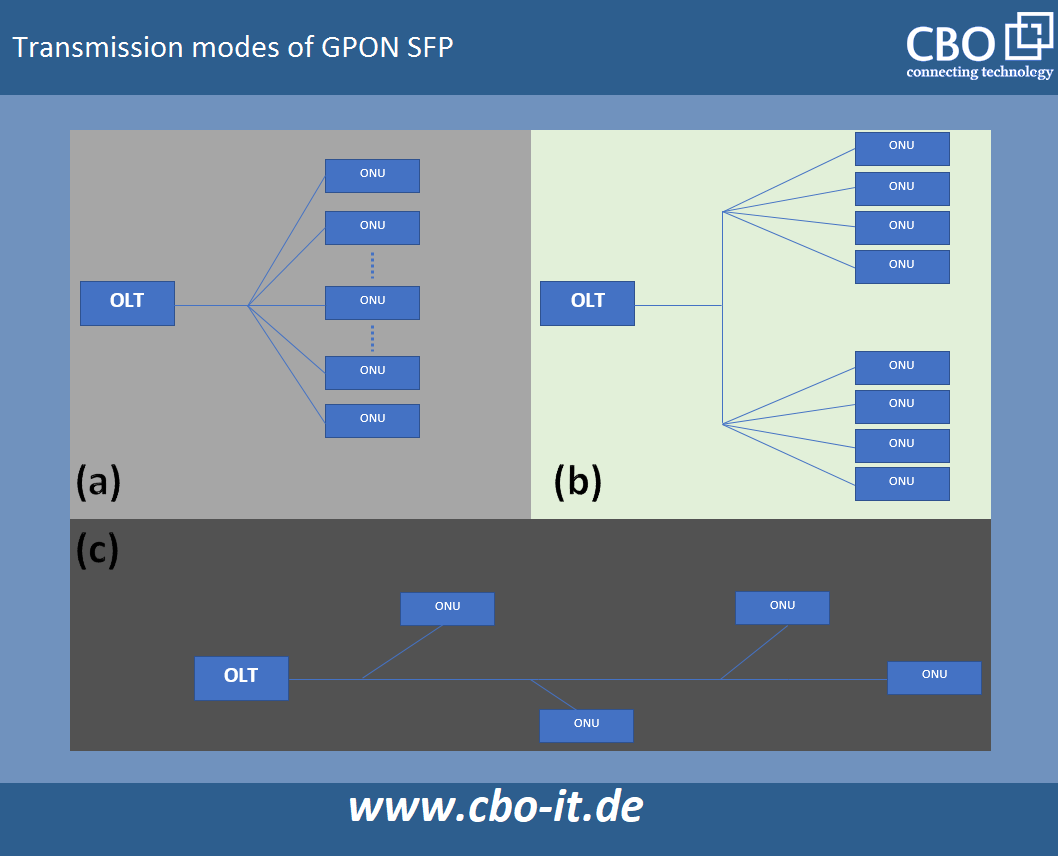GPON is short for Gigabit Passive Optical Network. It is one of the major technologies employed in optical fiber-based (FTTx) access networks, including;
- fiber to the business (FTTB)
- fiber to the curb (FTTC), etc.
- fiber to the home (FTTH)
A GPON network consists of two major active transmission components, which are; OLT (abbreviation is Optical Line Termination) and optical network unit (ONU) or optical network termination (ONT). The advanced version of OLT and ONT/ONU have triple-play GPON services, and for this, it uses packaged optical fiber modules. These modules are called GPON SFP transceivers. This blog is for introducing you to the basics of SFP GPON modules.

An Introduction to GPON SFP Transceivers
It is the type of optical gigabit module usually used in the GPON system, which is ITU-T G.984.2 compatible. GPON SFP is a two-directional module with an SC-type receptacle and operates over a simplex single-mode optical fiber optic cable. It can transmit and receive signals of various wavelengths between the OLT (Optical Line Terminal) at the network`s central office and the ONT (Optical Network Terminal) at the user`s premises. It uses both the upstream and downstream data through optical multiplexing. Following exhibit explain basics of the GPON networking;
Differences between Class B+ SFP and Class C+ S SFP
SFP GPON modules are categorized based on the devices they are plugged into. So we have GPON OLT SFP available for OLTs and GPON ONT or ONU SFPs available to be used with the devices deployed at the customer`s premises. Also, these modules are offered in two classes; Class C+ GPON SFP and Class B+ GPON SFP. The major distinction between the two is based on power transmission and reception sensibility. The following table provides the key differences between the GPON SFPs from each class.
Class C+ GPON SFP supports as many as 64 connections with user-end ONTs. Class B+ GPON SFP offers connections with up to 32 user-end ONTs. Whereas both the C+ and B+ OLT SFPs are pairable provided that the link loss budget remains within appropriate limits.

How can we differentiate between Ordinary BiDi SFP and the GPON SFP?
GPON SFP comes from the class of gigabit BiDi SFP modules; however, it is distinct from “ordinary” BiDi SFP transceivers in some features. Let us discuss some of the key differences between regular BiDi (bidirectional) SFP transceivers and GPON SFP transceivers.

Signal Transmission Mode
The optimal transmission mode for the conventional gigabit BiDi SFP transceivers, mainly used in the backbone network, is the point-to-point (P2P). They must be used in compatible matching pairs. Usually, BiDi modules come with an LC receptacle, unlike GPON SFP transceivers that use SC receptacles ..
GPON SFP works in point-to-multipoint transmission mode. One GPON OLT SFP module is deployed at the central office, and it can communicate with many GPON ONU SFPs through optical splitters. Thus, GPON networks are developed in tee shape or a tree shape usually.
Transmission Distance
Conventional gigabit BiDi SFP can offer a range of 160 kilometers over single-mode optical fiber cable while transmitting over 1590/1510 nanometer and 1510/1590 nanometer wavelengths. Whereas GPON SFP OLT and SFP ONT/ ONU transceivers can work through a transmission distance of 20 km
Advantages of Using GPON SFPs
GPON SFP is considered as a viable solution for consumers due to its convenient usage. It also minimizes the number of networking devices to be installed by ISPs. Before the advent of GPON ONT SFP modules and their usage in GPON networks, the ISPs had to install various types of hardware such as an optical module and a set-top-boxes at user premises.
The modern and advanced version of GPON SFP is much in smaller size comparatively and is also integrated with the triple-play services. Along with that, it also has lower consumption. The ISP (Internet Services Provider) generally offers an SFP GPON ONT module to the subscriber. The ISP usually helps in the installation of this modul. However, it is allowed that the subscriber can unplug the cable from the ISP`s provided router or hub and plug it in his preferred router or switch.
Conclusion
GPON SFP modules are used in the two key active components ONT/ONU and OLT in GPON networks. They are very crucial in maintaining the high-bandwidth and transmission rates within the distance of 20 km between the subscriber and the service provider. GPON SFP modules are classified into Class C+ and Class B+ and the critical difference between the two types is the difference between their Rx and TX sensitivity. This module has made easy the various applications of GPON services. It is a two-sided advantage as both the end-user and the network operator benefits from it to some degree.
 English
English
 Deutsch
Deutsch
 Espaniol
Espaniol










